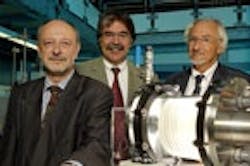Water Recycling System, Self-Contained
Overcrowded mega-cities without adequate water supplies or sewage disposal facilities, frequent flooding and extreme drought are problems that a new urban infrastructural concept can help solve. It has a flexible, water-saving vacuum sewerage network.
While Germans consume an average of 130 liters of clean water each day, they drink only three. A third of the total amount is flushed down the toilet. “Water is one of our most valuable resources, and far too precious to waste on transporting fecal matter,” says Professor Walter Trösch of the Fraunhofer Institute for Interfacial Engineering and Biotechnology IGB in Stuttgart. Together with Dr. Werner Sternad of the IGB and Dr. Harald Hiessl of the Fraunhofer Institute for Systems and Innovation Research ISI in Karlsruhe, he designed and created DEUS 21, a decentralized urban infrastructure system. The team won the Joseph von Fraunhofer Prize 2007 for this achievement. The jury was impressed by the process engineering used to treat water and the comprehensive approach to effective materials recycling.
“DEUS is an integrated model that looks at water as a commodity all the way from the faucet to the treatment plant,” says Professor Trösch. A novelty in the scientists’ approach is that they collect rainwater instead of channeling it away unused through the sewers. It is collected separately from wastewater and treated in a modern membrane plant. As the membrane’s pores are even smaller than bacteria and viruses, pathogens can be filtered out. The resultant germ-free water meets German drinking water standards (TVO). This very soft water flows back into households through a separate supply network, and can be used for showering or for washing dishes or clothes. Residents use less drinking water and save money.
Wastewater from the households is then collected in a vacuum sewerage system. It offers the special advantage of being able to ingest shredded kitchen scraps, obviating the need for separate biological waste collection. The wastewater is transported to a hermetically sealed high-performance reactor containing rotation filters, which consist of porous ceramic microfiltration membranes. These filters remove everything that is bigger than 0.2 micrometers from the wastewater, including the bacteria that decompose organic waste. Any biogas that is recovered can be used to generate power and heat. Nitrogen and phosphate are also reclaimed from the wastewater and processed to produce high-quality fertilizer. What remains is the purified wastewater which meets the quality requirements of the European directive on bathing water quality. It can be drained away or discharged into a body of water.
Source: Technology News Daily
